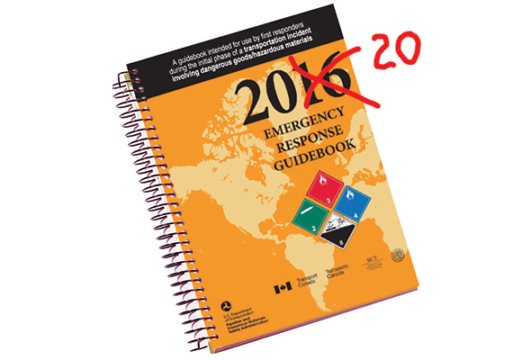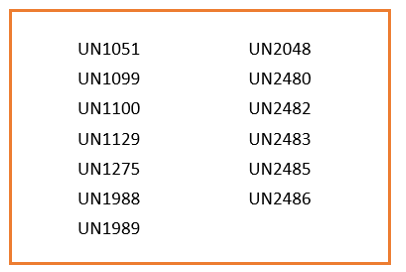
The Emergency Response Guidebook (ERG) is essential for all frontline Dangerous Goods personnel, and the 2020 version is finally almost here! We expect to ship our first deliveries in four to five weeks.
As expected, this year’s ERG has a multitude of changes from the 2016 version, as PHMSA has assembled an international group of scientists, engineers, and regulatory experts to improve the guidebook and make it more useful for hazmat organizations and first responders.
Here’s a list of the most important changes PHMSA has made from the 2016 edition to the 2020 edition. They’re listed based on the color of their section in the guidebook.
White pages
- Reviewed the guidebook and changed these sections to make them easier to read and understand:
- Introduction to Green Tables
- Protective Actions
- Background on Table 1 – Initial Isolation and Protective Action Distances
- How to use Table1- Initial Isolation and Protective Action Distances
- User’s Guide
- Protective Clothing
- Fire and Spill Control
- Criminal or Terrorist Use of Chemical, Biological and Radiological Agents
- Added a new decontamination section to describe basic contamination theory and proper decontamination techniques
- Reworked the BLEVE section into the BLEVE and Heat Induced Tear section. This section now shows the cause and hazards of BLEVEs and Heat Induced Tears
- Added:
- Lithium battery label and marking, and gasoline placard to the Table of Markings, Labels, and Placards
- New terms and their definitions to the Glossary:
- Adsorbed gas
- Boil over
- Flooding quantities
- High expansion foam
- Organic peroxide
- Refrigerated liquefied gas
- Basic information on Improvised Explosive Devices (IED) in the Criminal or Terrorist Use of Chemical, Biological and Radiological Agents section
- A top view illustration of the TC117/DOT117 to the Rail Car Identification Chart
- Illustration of an Intermodal Freight Container to the Road Trailer Identification Chart
- Improved the illustrations in the Rail Car and Road Trailer Identification Charts
Yellow and Blue Pages
- Removed the UN numbers for Chemical Warfare Agents and moved them to the beginning of the yellow pages and Table 1. They’re still in alphabetical order in the blue pages
- Added fifteen new materials (UN3535 to UN3549) listed in the UN Recommendations on the Transport of Dangerous Goods (up to the 21st revised edition)
- Deleted out of date materials based on the UN Recommendations on the Transport of Dangerous Goods and North American regulations
- Re-evaluated the polymerization hazard criteria for some high-risk materials, and added the polymerization marking (P) to 13 materials.

- Re-analyzed the chemical properties of many materials to make sure that they’re assigned to the appropriate Orange Guide. Also moved 34 materials to a different Orange Guide.

Orange Pages
- Added an introduction called “How to use the Orange Guides”. This new section explains the 4 parts of an Orange Guide. In this section, the terms “evacuate” and “isolate” are defined
- Merged Guide 121 with Guide 120. Guide 121 now states: “Page intentionally left blank”. Products that referred to Guide 121, now refer to Guide 120
- The Canadian Nuclear Safety Commission re-evaluated the Orange Guides for radioactive materials (Guide 161 to Guide 166) for technical accuracy
- The Occupational Safety and Health Administration (OSHA) and National Institute for Occupational Safety and Health (NIOSH) validated the Orange Guide for infectious substances (Guide 158)
- Moved the safety distances that were in the Public Safety section to the Evacuation section. Now all safety distances in an Orange Guide fall under the same heading
- Added safety distances for ammonium nitrate on fire to Guide 140
- Increased safety distances for materials on fire in Guide 114 from 500 m (1/3 mile) to 800 m (1/2 mile). This was based on consultations with stakeholder subject matter experts
- Added CAUTION sentences for specific compounds. These sentences:
- Describe inhalation toxicity concerns due to hydrogen sulfide gas in petroleum crude oil:
- in Guide 128
- Describe proper firefighting and spill remediation techniques for liquefied natural gas (LNG):
- in Guide 115
- Describe the explosive nature, even in the absence of air, of:
- Acetylene in Guide 116
- Ethylene oxide in Guide 119
- Describe the hazards of an invisible flame for:
- Ethanol in Guide 127
- Methanol in Guide 131
- Carbon monoxide in Guide 168
- Describe the toxicity of pentaborane
- In Guide 135
- Describe the flammability hazards of some aerosols
- In Guide 126
- Describe inhalation toxicity concerns due to hydrogen sulfide gas in petroleum crude oil:
- With the help of instructors from the United States National Fire Academy (NFA), did a comprehensive review of the Orange Guides
- Some sentences were added, deleted, or changed to give the best available advice and use consistent and clear language
- Separated the references to highlighted and non-highlighted materials in the Evacuation section and simplified the language to make it easier to understand
Green Pages
- Revised the distances in Table 1 and Table 3
- Organized Table 3 by ID number (numerical order of material) instead of alphabetical order
- Revised “How to use Table 2” to clearly explain that the information in Table 2 is for information purposes only. Table 2 doesn’t change the suggested response strategies listed in the related Orange Guide, Table 1 and Table 3
- Added Table 3 container capacities in the section called “How to use Table 3”
- Added a visual tab in the green page border to make it easier to see the differences between Table 1, 2 and 3. The tables are all still the same green color but the side margins now include a series of white boxes that go down the page with the words Table 1, Table 2, or Table 3
- Added more Toxic Inhalation Hazard (Poison Inhalation Hazard in the U.S.) materials in Table 1 and Water-Reactive Materials in Table 2:
- UN1390 to Table 1 and Table 2
- UN2965 to Table 1 and Table 2
- UN3539 to Table 1
We expect to begin shipping copies of the 2020 ERG in September, but you can make sure you get them to all your frontline staff by getting your orders in today. Don’t wait! Pre-order your 2020 ERG now!
Labelmaster is a full-service provider of goods and services for hazardous materials and Dangerous Goods professionals, shippers, transport operators and EH&S providers. See our full line of solutions at labelmaster.com.


